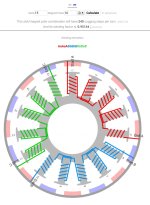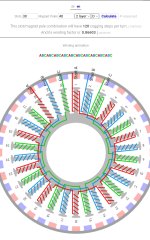I've been thinking about building a motor for a while. I've learned a ton from this site and still have a lot more to learn.
I have a large SLA printer hopefully arriving soon (Phrozen Mega) and have a seat of Solidworks for my day job that I will be using for CAD.
It needs to be easy to assemble, build, and use as of the shelf components as possible.
I'm not sure on coreless yet, not clear yet to me on the trade offs. What terms can I look up to better understand this?
I'm also unsure on axial vs radial design yet, I'd be ok with either. I think magnet sourcing /availability will drive this.
My thought is to use 22.5° arc magnets (16) that seem to be somewhat readily available. I'd like to do a Halbach setup but I'm not sure if the magnets that redirect the flux need to be the same size (physical or magnetic strength) as the magnets doing the motor work. My current thinking is arc magnets with smaller rectangular halbach magnets between them.
This part might seem silly but it seems like it could work out really well. 15 slot / 16 magnet (22.5°) seems sensible in a lot of ways besides looking really wrong at first glance. am I missing something?

This would allow for 3 modular (identical) pieces of stator and seems like they would be really easy to wind and swap between delta and wye.
My last questions currently are on litz wire size. I've seen ac frequency mentioned in choosing the wire diameter. This would be targeted to the ac frequency of your expected normal motor speed?
I've also seen some huge claims on current capacity using litz wire. Does anyone have any references / calculations to help size the stands, number of strands, and current capacity?
I have a large SLA printer hopefully arriving soon (Phrozen Mega) and have a seat of Solidworks for my day job that I will be using for CAD.
It needs to be easy to assemble, build, and use as of the shelf components as possible.
I'm not sure on coreless yet, not clear yet to me on the trade offs. What terms can I look up to better understand this?
I'm also unsure on axial vs radial design yet, I'd be ok with either. I think magnet sourcing /availability will drive this.
My thought is to use 22.5° arc magnets (16) that seem to be somewhat readily available. I'd like to do a Halbach setup but I'm not sure if the magnets that redirect the flux need to be the same size (physical or magnetic strength) as the magnets doing the motor work. My current thinking is arc magnets with smaller rectangular halbach magnets between them.
This part might seem silly but it seems like it could work out really well. 15 slot / 16 magnet (22.5°) seems sensible in a lot of ways besides looking really wrong at first glance. am I missing something?

This would allow for 3 modular (identical) pieces of stator and seems like they would be really easy to wind and swap between delta and wye.
My last questions currently are on litz wire size. I've seen ac frequency mentioned in choosing the wire diameter. This would be targeted to the ac frequency of your expected normal motor speed?
I've also seen some huge claims on current capacity using litz wire. Does anyone have any references / calculations to help size the stands, number of strands, and current capacity?


